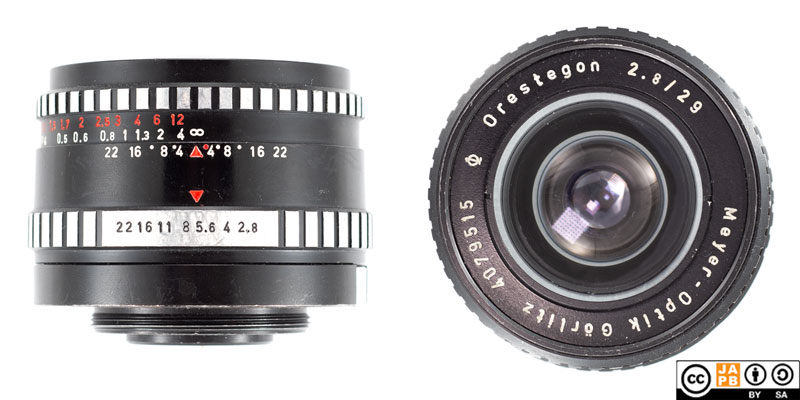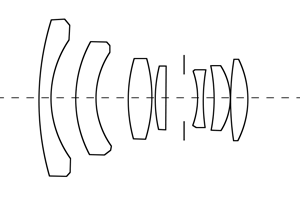Pekka Buttler, 08/2022 (Updated 11/2024)

Specifications
The table below summarizes the lens’ key specifications:
| Brand: | Meyer-Optik Görlitz | Lens name | Orestegon 2.8/29 |
| Focal length 1 | 29 mm | Angle-of-view 2 | 73 ° |
| Maximum Aperture | f/2.8 | In Production | 1966–1970 |
| Lens mounts | M42 | Other Lens Mounts | Exakta RTL 1000 |
| Length 3 | 44,3 mm | Diameter 4 | 65,1 mm |
| Filter ring diameter | 55 mm | Weight | 245 grams |
| Lens element count | 7 | Lens group count | 7 |
| Aperture blades (S/R/C) 5 | 6 S | Focus throw | 135 ° |
| Minimum focusing distance | 25 cms | Maximum magnification | 1:6,5 |
| Has manual aperture ring | YES | Has Manual focus ring | YES |
| Aperture mechanism type | Automatic | Aperture click stops 6 | 2.8•4•5.6•8•11•16•22 |
Further notes:
• The MOG Orestegon is an Auto-only lens (no Manual aperture mode available). The lens offers a button for depth-of-field preview.
• The name Orestegon identifies the lens as one of MOG’s later series (all MOG lenses post-1963 are named Orest-something) and the -gon suffix identifies it as a wide-angle lens.
• The Orestegon was replaced in 1970 by the identical-specs Pentacon 29 mm f/2.8 [data sheet], that remained in production until the early 1990s (past the demise of the German Democratic Republic).
• While only one mm (≈two degrees) wider than the Lydith, the Orestegon had two clear advantages: It was more than half-a-stop brighter and was – from the onset – designed as an auto-aperture lens.
• While (from today’s viewpoint) an f/2.8 wide-angle is nothing special, at the time of its launch (1966), the standard wide-angle was still typically an f/3.5 design and few companies sported such a bright wide-angle. The bulk of the Japanese competition introduced their 28/2.8 lenses roughly a decade later.
• For further notes on Meyer-Optik Görlitz and especially their naming logic, see the JAPB article on MOGnames.
• Note please, my copy of the Orestegon (pictured above) is unlikely to ever suffer from Schneideritis, because it has either been assembled without any lacquer on the sides of the lens elements, or a previous owner has decided to remove the lacquer. Whether this is characteristic of a large share of Orestegons I cannot say (I’ve seen some similar lenses on eBay). Importantly, I cannot find signs that it would negatively effect image quality.

History of Meyer-Optik Görlitz
The original Meyer-Optik Görlitz (not the modern company that has taken the classic company’s name) was founded in the town of Görlitz (modern-day Germany) by Hugo Meyer in 1896, and remained in existence until the state-directed merger into VEB Pentacon 1970. Due to its vicinity with the German camera and optics industries in Saxony (Dresden, etc.), Meyer-Optik was from an early stage heavily involved with manufacturing lenses for all kinds of cameras, but the company’s real golden age started with the advent of interchangeable lens cameras, where Meyer-Optik was uniquely placed to offer a cost-effective alternative to premium brands such as Carl Zeiss Jena.
Meyer-Optik was pronouncedly a camera lens manufacturer and never had serious ambitions for pursuing horizontal integration (diversifying into cameras and other photo gear). Instead, MOG pursued a vigorous strategy of seeking economies of scale, combined with never putting too many eggs in any basket – typically Meyer-Optik would choose which designs to put into production based on being able to cover as many platforms/mounts with one basic design. As a result, many early MOG designs were made available for a wide range of camera platforms. Later, as the number of alternative platforms diminished, that strategy had to go in favour of a strong focus on M42 and (to a somewhat lesser extent) Exakta. Even so, throughout the 60s, MOG vigorously pursued innovative designs and could by the end of the decade proudly offer a wide range of high-quality, cost effective designs.
When the lens maker Meyer-Optik was then merged with the camera maker Pentacon, it became obvious that the role the company (and its product portfolio) was intended to play was to aid Pentacon in its designs of gaining a significant global market share in the price-conscious consumer segment (and help bring hard currency to the G.D.R). Instead of focusing on continued optical innovation, the new overlords were more keen on redesigning lenses for greater economy and easier manufacture. As a result, the pace of optical innovation at MOG/Pentacon fell drastically, and very few new designs or significant redesigns were to be forthcoming in the next two decades.
However, the Meyer-Optik Orestegon comes from what would later be known as the golden decade of Meyer-Optik. While somewhat odd with its non-standard focal length (29 mm), the Orestegon managed to beat most of the major competition by almost a decade in producing a bright 28-29 mm wide-angle lens.
Versions
The Orestegon was originally introduced only for the M42 mount. Subsequently a version was also manufactured for the Exakta mount, but those remain rarer today. Going forward from Meyer-Optik to Pentacon, the Orestegon was redesigned and re-engineered several times, resulting in a great number of outwardly distinguishable versions.
Adapting
n.B! The following applies this lens in either Exakta or M42 mount.
This lens cannot be used natively on any current SLR or dSLRs. To use it in its native environment, you will need an Exakta or M42-mount film body. Luckily there are a lot of those (especially in M42 mount) available.
Thanks to being a fully manual lens (manual aperture, manual focus), the lens can be adapted to all mirrorless cameras using a suitable adapter. Moreover, both Exakta and M42 lenses are so uncomplicated that a simple ‘dumb adapter’ will do the job perfectly. Moreover, due to the popularity of both mounts, special adapters (helicoid adapters, tilt/shift adapters) are readily available. Alternatively, one can choose to daisy-chain adapters (e.g. M42->Canon EF; Canon EF –> mirrorless) which also opens up a wide range of speed boosters .
Using m42 and Exakta lenses on dSLRs can also be an easy option, depending on which dSLR.
• Canon EF has the shortest flange focal distance among full-frame dSLR’s and Canon’s wide range of dSLRs are able to mount both M42 and Exakta lenses perfectly using a simple adapter ring.
• Minolta / Sony A dSLRs are likewise able to mount M42 lenses using a simple adapter ring, but for Exakta lenses, the difference in flange focal distances is not enough to enable reaching infinity focus without an adapter that uses corrective optics.
• Pentax K dSLRs are likewise able to use M42 lenses using a simple adapter ring, but for Exakta lenses an adapter that uses corrective optics would be needed to allow infinity focus.
• Nikon F dSLRs have a long flange focal distance, meaning that mounting either M42 or Exakta lenses needs an adapter that uses corrective optics to allow anything close to infinity focus.
Footnotes
- Focal length is (unless stated otherwise) given in absolute terms, and not in Full-frame equivalent. For an understanding of whether the lens is wide/tele, see ‘Angle-of-view’. ↩︎
- Picture angle is given in degrees (based on manufacturers’ specs) and concerns the diagonal picture angle. Rule of thumb:
> 90 ° ==> Ultra-wide-angle
70–90 ° ==> Wide-angle
50–70 ° ==> Moderate wide-angle
40–50 ° ==> ‘Standard’ or ‘normal’ lens
20–40 ° ==> Short tele lens
10-20 ° ==> Tele lens
5-10 ° ==> Long tele lens
< 5 ° ==> Ultra-tele lens ↩︎ - Length is given from the mount flange to the front of lens at infinity. ↩︎
- Diameter excludes protrusions such as rabbit ears or stop-down levers. ↩︎
- S=straight; R=rounded; C=(almost)circular at all apertures. ↩︎
- Numbers equal aperture values on aperture ring; • intermediate click; – no intermediate click. ↩︎